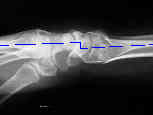- Discussion:
- view should demonstrate the metacarpals, lunate and radius aligned
- hand will appear slightly palmar flexed;
- w/ proper technique, the volar pisiform will lie between the distal aspect of scaphoid and the palmar aspect of the head of the capitate;
- Specific Point of Evaluation:
- fat pads
- palmar slope
- capitolunate angle:
- wrist must be in a neutral position;
- normally the distal radius, lunate, capitate, and third metacarpal are co-linear;
- dorsal intercalated segment instability;
- in DISI pattern, the lunate is dorsiflexed 45 deg in relation to capitate;
- volar intercalated segment instability
- in VISI there is a zig-zag deformity pattern, so that the lunate is volar flexed in relation to the capitate;
- scapholunate angle:
- wrist must be in a neutral position for an accurate diagnosis;
- normal scapholunate angle is about 47 deg, range 30 to 60 deg;;
- greater than 70 deg is abnormal;
- ulnar deviation lateral view:

- normally ulnar deviation will cause the lunate to dorsiflex and shift volarly, and the radio-luno-capitate alignment resembles a DISI pattern
- volar shift of the lunate helps maintain the normal co-linear relationship of the radius and the capitate;
- w/ mid carpal ulnar instability, the lunate will dorsiflex, but will not have normal palmar translation;
- hence, the longitudinal axis of the capitate lies above the axis of the radius;
- this "zig zag" deformity would be expected to cause symptoms following distal radial fractures even if the loss of volar tilt was minimal
- Lateral of Hand:
- hand views include the wrist, however, penetration of hand may be inadequate for accurate evaluation of the wrist;
- fingers must be spread in a cascade fashion to profile bones & joints;
- if fingers are flexed on the oblique view, the middle and distal phalanges will be foreshortened, with overlaping of the IP joints;
- positioning of the hand in the oblique position so that the fingers are extended prevents foreshortening of the phalanges and IP joints
Traumatic Instability of the Wrist. Dobyns J, et al. AAOS Inst Course Lect. 1975;24:182-199.

